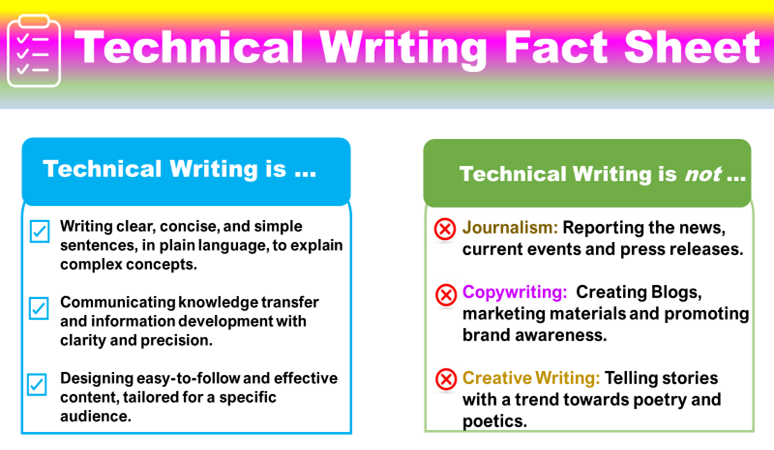Your cart is currently empty!

Technical Writing Fact Sheet
Technical writing is pivotal in translating complex technical concepts into accessible and actionable information for specific audiences.
Ensuring clarity, accuracy, and user-centeredness is paramount to creating adequate technical documentation.
Key Characteristics
- Clarity: Ensures that the message is straightforward and easy to understand.
- Accuracy: Provides precise information.
- Conciseness: Delivers information using the fewest possible words without sacrificing clarity.
- User-Centered: Focuses on meeting the needs and understanding level of the intended audience.
- Structured: Organizes information logically and coherently.
- Visual Elements: Utilizes diagrams, charts, and graphs to enhance understanding.
Common Types of Technical Documents
- Manuals: Guides that provide specific instructions or information.
- Reports: Documents that describe and analyze experiments, studies, or projects.
- Proposals: Documents that suggest a plan or project to address a problem or need.
- User Guides: Instructions aimed at helping end-users operate a product or system.
- White Papers: In-depth reports that provide solutions to problems.
- Data Sheets: Brief documents that provide specifications or features of products.
Industries That Hire Technical Writers

Essential Elements of Technical Writing
- Title: Clearly indicates the topic or purpose of the document.
- Introduction: Provides a brief overview of the topic and its relevance.
- Body: Contains detailed information, organized into sections or headings.
- Conclusion: Summarizes the key points and may suggest next steps or actions.
- Glossary: (if applicable) Explains technical terms and jargon.
- References: Cites sources and provides additional reading.
- Appendices: (if applicable) Offers supplementary information.
Best Practices
- Understand Your Audience: Tailor the content to meet the needs and knowledge level of the target audience.
- Use Active Voice: Active voice for clearer and more direct sentences.
- Incorporate Visuals: Use images, charts, and graphs to support and enhance the text.
- Be Consistent: Ensure consistent use of terminology, abbreviations, and units of measure.
- Proofread: Check for grammatical errors and typos and ensure accuracy in the information provided.
- User Testing: Validate the document’s effectiveness by having actual users review and provide feedback.
Challenges in Technical Writing
- Translating Technical Jargon: Making complex technical terms and concepts understandable to non-experts.
- Maintaining Accuracy: Ensuring that the technical details provided are accurate and up-to-date.
- Engaging the Audience: Keeping the reader’s attention while conveying technical information.
- Global Communication: Adapting technical documents for international audiences, considering language and cultural differences.
Tools Used in Technical Writing
- Word Processors: Microsoft Word and Google Docs for creating and formatting documents.
- Graphic Design Software: Adobe Illustrator and Photoshop for creating visuals.
- Screen Capture Tools: Snagit and snipping tools for taking screenshots and recording screen activities.
- Help Authoring Tools: MadCap Flare and Help & Manual for creating online help systems.
- Content Management Systems: Confluence / JIRA and SharePoint for managing and storing documents.

Cheers! 🚀
Veronica
2 responses to “Technical Writing Fact Sheet”
Also common across industries – companies that need employee manuals or team SOPs to be written.
Absolutely!